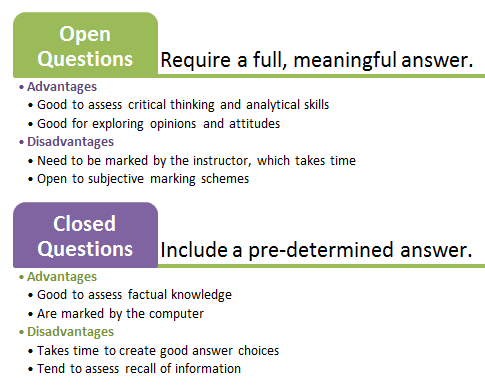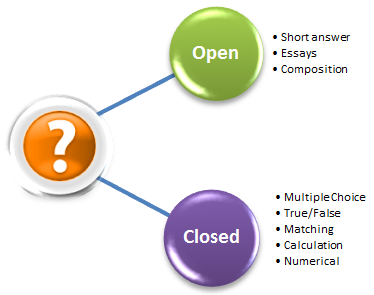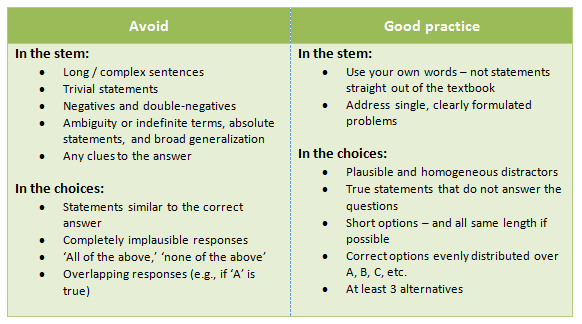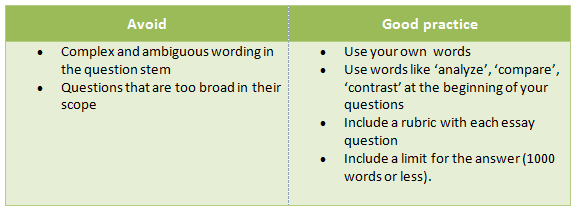Assessment, Quizzes and Gradebook
| Site: | Technology-Enabled Learning Lounge |
| Course: | Developing & Teaching Online Courses |
| Book: | Assessment, Quizzes and Gradebook |
| Printed by: | Guest user |
| Date: | Tuesday, 23 December 2025, 9:55 PM |
Description
This book guides you through the process of creating quizzes in Moodle. You will go over the most common types of questions used in quizzes and assignments and you will learn how to set up the student gradebook.
Assessment Events
Based on the assessment (summative and formative) and self-assessment strategies you have planned for your course, you will create a variety of assessment elements for your course. These may include:
- Quizzes with different types of questions
- Essays
- Discussions
- Project work (individual and group)
The specific learning objectives will guide the choice of assessment events you will use for the formative assessment in the same way the course learning goals will guide the assessment events you will use for the summative assessment.

Examples
- If one of your course goals is that learners will be able to
"build a dinning room table and four chairs in a specific type of wood and according to specific carpentry standards"
then part of your summative assessment may in all likelihood be a group project in which students will build these pieces of furniture.
- If one of the learning objectives for a specific section of the course is that learners will be able to
"outline the steps required to build a chair in a specific type of wood"
then your summative assessment will likely include either an essay question where you ask students to outline and explain each step required in building a chair, or a multiple choice question asking students to select all the alternatives that are steps in building a chair, or an ordering question where you give students the steps in mixed order and ask them to put them in the correct order.
Using Quizzes
Quizzes are an effective tool to assess student learning and can be used for summative and formative assessment as well as self-assessment. Quizzes are a particularly effective tool to use in online and blended learning environments as the feedback, marking and grading can all be automated, saving a considerable amount of instructor time while meeting the needs of students.
Question Types
The types of questions available for online learning are organised into two broad categories:
 |
 |
Quizzes in LMS
Typically, LMS store questions in databases so that you can create quizzes with randomized groups of questions. Ideally, you develop multiple questions to test the same learning objective and store them in question banks. This allows you to later create quizzes that will "pick" random questions from the question bank. You may have several quizzes for the same section but all with different questions, which prevents cheating. In some LMS you can also randomize the questions so that each learner will get a slightly different quiz for the same content section. You will learn how to implement some of these features in the Quiz Module in Moodle as you prepare to do your Create a Quiz assignment.
Types of Questions
Multiple Choice
Multiple choice questions include the question (stem) with multiple possible answers (choices), including the correct answer and several incorrect answers (distractors). In an online quiz, students select the correct answer by clicking the choice they think is correct and the computer stores their answer.

Example
What are distractors in closed types of questions?
A) Elements of the quiz layout that distract attention from the questions
B) Incorrect but plausible choices used in multiple choice questions
C) Unnecessary clauses included in the stem of multiple choice questions
Answer: B)
Feedback:
A) Not quite. Distractors are not related to the format of the quiz.
B) Correct! Distractors the incorrect statements that are used as a choice in multiple choice questions.
C) Distractors are never included in the stem of the question.
Students can generally answer these type of questions quite quickly. As a result, they are often used to test students' knowledge of a broad range of content, mostly factual. Creating these questions can be time consuming because it is often difficult to generate several plausible distractors. However, the marking is automated, which saves instructor time in the long run.
Tips to Write Good Multiple Choice Questions

True / False
True/False questions include one statement which students are asked to identify as true or false.

Example
A True / False question may offer up to four response options.
True
False
Answer: False
Feedback for correct: This statement is indeed false, as a True / False question only offer two options for the answer.
Feedback for incorrect: This statement is False because this type of question only offers two answer choices.
Like multiple choice questions, true/false questions:
- Are usually used to assess basic knowledge of course content and to check for common misconceptions
- Allow students to respond quickly so exams can include a large number to test knowledge of a broad range of content, mostly factual
- Are automatically graded by the computer
True/false questions provide students with a 50% chance of guessing the right answer. For this reason, a larger number of multiple choice questions are often used in quizzes instead of true/false questions.
Tips to Write Good True/False Questions

Matching
Matching questions require learners to pair specific items, such as definitions, with specific concepts.

Example
Match the following question types with their correct definitions:
| A) True / False | 1) Requires learners to pair items |
| B) Multiple Choice | 2) Requires learners to identify statements as true or false |
| C) Matching | 3) Requires learners to select the correct answer from a list of distractors |
Answer: A) - 2); B) - 3); C) - 1)
Feedback: In the case of these types of questions there could be a variety of incorrect answers, difficult to predict. Therefore, it makes more sense to provide students with overall feedback on the question and perhaps some remediation if necessary. True/False questions require learners to identify statements as true or false, while multiple choice questions require students to pick the correct answer from a list of distractors and matching questions require students to pair the list of items provided. If you didn't get this question right, it is important that you review the content on this topic again, or contact your instructor for further clarification.
These questions are generally quick and easy to create and are marked automatically by the computer. However, students typically require more time to answer these questions in comparison to multiple choice or true/false questions.
Tips to Write Good Matching Questions

Fill-in-the-blank
Fill-in-the-blank questions are composed of an incomplete statement for students to complete by typing one or two words that will make the statement correct.

Example
A question that requires students to associate prompts and options is called a ___________ question.
Answer: matching
Feedback for correct: Well done! This is indeed what defines a matching question.
Feedback for incorrect: Not quite... in this type of question students must match the prompts with the option, therefore we call it a matching question.
Tips to Write Good Fill-in-the-blank Questions

Regardless of what type of closed question you choose to use in your course, make sure that you include meaningful and relevant feedback for all the options.
Types of Questions
Short Answer
Short answer questions require a written answer that varies in length from one or two words to a few sentences. They are most often used to test basic knowledge of key facts and terms.

Example
“What is the type of question that requires students to associate a set of prompts with a set of options?”
Answer: Matching questions
Feedback for correct: Well done! This is indeed what defines a matching question.
Feedback for incorrect: Not quite... in this type of question students must match the prompts with the option, therefore we call it a matching question.
You may also use short answer questions to test higher thinking skills, including analysis or evaluation.

Example
“Will you include short answer questions on your next quiz? Please justify your decision with two to three sentences explaining the factors that have influenced it.”
Feedback: As you can probably guess, it is challenging to provide feedback for this type of question, as it all depends on the thinking behind the answer. Therefore, these types of questions are more effective when they are marked by the instructor, who can provide meaningful and relevant feedback after reading learners' answers. However, if you don't have instructor time allotted, you can still provide learners with some guidance:
"Check that in your answer you covered the advantages and disadvantages of using short answer questions in regard to the assessment of higher level thinking skills."
Short answer questions are relatively easy to create and take less time than crafting multiple choice questions. Unlike matching, true/false, and multiple choice questions, short answer questions make it difficult for students to guess the answer. Short answer questions allow learners the flexibility to explain their understanding and demonstrate creativity. However, this also means that marking is typically done by the instructor and can be subjective.
Tips for Writing Good Short Answer Questions

Essay Questions
Essay questions are excellent to test critical thinking patterns and learners' abilities to analyze and evaluate a situation or problem. Essay questions are unstructured questions that elicit a complex response which may vary in length from a couple of paragraphs to a few pages. Responses to this type of question demonstrate how students integrate the course material with the ability to apply their knowledge to specific situations. There is usually not a right or wrong answer to essay questions, which allows students some creativity in their responses but also creates marking challenges for the instructors. To mitigate marking challenges and help ensure equitable marking systems, it is extremely important that essay questions include marking rubrics that are shared with learners.

Example
- Analyse the advantages and disadvantages of using essay questions vs short answer questions in formal summative examinations.
- Compare and contrast the advantages and disadvantages of essay questions as they relate to testing higher thinking skills in adult learners.
Feedback: Since there is no right or wrong answer for this type of question, your feedback should include any comments you deem appropriate to guide the thinking process of the learner. If the learner is on the right track, make sure your feedback includes a reinforcing message.
Tips for Writing Good Essay Questions


Web Resources
The following are the question types supported in Moodle:

Optional Activity
Watch the video tutorials about creating quizzes in Moodle and then create a quiz for your course.
When you finish watching the Moodle video tutorials and after you create your quiz in Moodle, you can move on to the final book in this section which explores the use of engagement activities and the types of activities that can be included in your course.
Using the Gradebook
Most LMS include a gradebook where students can look up their grade information and where instructors can upload grades and feedback. The gradebook is an axcellent tool to give students an overview of how they are doing in the course. In Moodle, all assignments are automatically attached to a gradebook.

Web Resources
- The Moodle documentation includes a detailed section on the gradebook and its functionality.
- To learn how to use the gradebook in Moodle, watch the video tutorials provided.